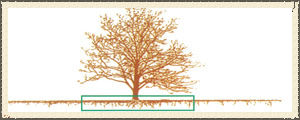Lee’s Late Winter Lawn Tips
Even though lawns are still dormant, now is the time to plan a strategy to have a beautiful, healthy lawn this summer. By doing a few simple things now, you will get a jumpstart on problematic early growing season problems.
Look for dry areas. Places where the snow melts first are prime areas for mites to cause damage during the winter. Watering these areas on warm winter days can help replenish the water the mites are draining from the blades of grass, while also knocking down the adult mite populations. If these dry areas are getting ‘crunchy’ to walk on, it’s a sure sign of mite damage. (Dormant grass should still be soft.) Mountain High does offer winter mite sprays to cut down on damage.
Should mites do heavy damage recovery will be slow. Often these areas will stay brown considerably longer than the rest of the yard, and the worst cases may have to be repaired with seed or sod in April or May.
Some areas of the lawn may thin out during the winter. Several common causes of lawn thinning include insect, rabbit, and disease problems. Heavy traffic, poor soil fertility and too much shade are also common factors to a thinning yard. Poor maintenance such as improper mowing and watering can contribute to this as well. An area in decline can really suffer and could even totally die out during the winter months.
To help struggling areas of the lawn, keep traffic off as much as possible. Often areas of heavy shade get more sun during the winter and early spring because there are no leaves on the trees. If this is the case, try to keep those areas open, moist, and sun exposed.
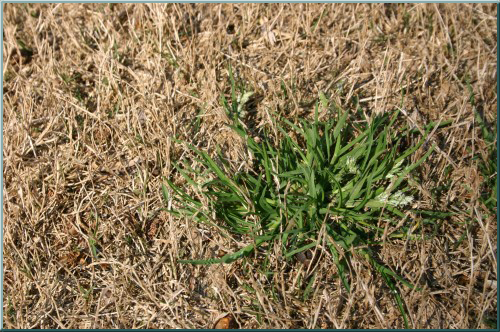 Winter weeds can be a problem. While many weeds dies out in the late fall after producing seeds for the following year, some weeds don’t die. Early spring applications of weed killer can bring them under control before they cause heavier weed infestations. This is why Mountain high lawn technicians start in late February or early March. Winter weeds can be a problem. While many weeds dies out in the late fall after producing seeds for the following year, some weeds don’t die. Early spring applications of weed killer can bring them under control before they cause heavier weed infestations. This is why Mountain high lawn technicians start in late February or early March.
One of the more common lawn diseases over the winter is 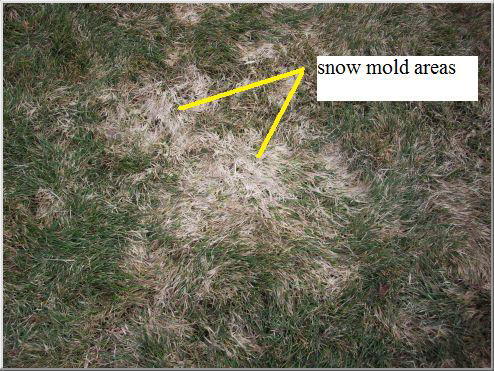 snow mold. Snow mold is either grey or pink in color, and causes splotches of matted down grass. There is no need to treat this with a fungicide. Instead, fluff up the grass with a rake to allow air flow. Lightly fluffing the grass in the middle of winter in these areas will prevent long lasting damage later. snow mold. Snow mold is either grey or pink in color, and causes splotches of matted down grass. There is no need to treat this with a fungicide. Instead, fluff up the grass with a rake to allow air flow. Lightly fluffing the grass in the middle of winter in these areas will prevent long lasting damage later.
Most damaging lawn insects are not active now, but they may have damaged your lawn last summer or fall. These bugs are primarily a problem May through early October, and if areas of your lawn were damaged insects are often the problem. Getting a mid-spring application of insect control (late April – early May) can drastically cut down on re-infestations. Mountain High offers professional lawn insect control.
One of the leading causes of decline in turf quality is shade. As trees and shrubs grow larger they tend to create more shade in larger areas. This change in the environment often leads to grass thinning. In many cases tree or shrub thinning will allow enough sunlight through to allow the grass to stay lush. If not, landscaping with shade-tolerant plants may provide the best long-term solution.
For more on winter lawn tips, click here: |








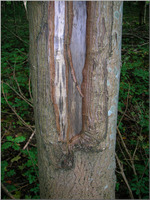 degree days to freezing temperatures below zero for multiple day stretches. These conditions place significant stress on our trees. Mild temperatures can promote an early break from dormancy, which often leads to freeze damaged leaf and bud tissue. Massive temperature swings may damage vascular tissue inside the tree when moisture in the cells expands due to freezing. Injury from cold temps and large temperature swings can persist long into the growing season, and it may impact processes such as flowering and fruit production. Damage can also extend into significant trunk injury known as “sun scald” or “frost cracks”. Heavy snows can destroy branches and impact tree structure for years to come.
degree days to freezing temperatures below zero for multiple day stretches. These conditions place significant stress on our trees. Mild temperatures can promote an early break from dormancy, which often leads to freeze damaged leaf and bud tissue. Massive temperature swings may damage vascular tissue inside the tree when moisture in the cells expands due to freezing. Injury from cold temps and large temperature swings can persist long into the growing season, and it may impact processes such as flowering and fruit production. Damage can also extend into significant trunk injury known as “sun scald” or “frost cracks”. Heavy snows can destroy branches and impact tree structure for years to come. be difficult. Trunk wrapping with a layer of insulated paper can offer a measure of protection from the intense sun exposure. Supplemental watering can protect sensitive root tissue during mild temps and drought periods. Protecting roots in the winter will help to prevent lags in growth when spring arrives. It is also very important to plan ahead when it comes to pruning your trees. The time and attention you spend on corrective pruning will pay big dividends when it comes to preventing storm damage in the canopy of your trees.
be difficult. Trunk wrapping with a layer of insulated paper can offer a measure of protection from the intense sun exposure. Supplemental watering can protect sensitive root tissue during mild temps and drought periods. Protecting roots in the winter will help to prevent lags in growth when spring arrives. It is also very important to plan ahead when it comes to pruning your trees. The time and attention you spend on corrective pruning will pay big dividends when it comes to preventing storm damage in the canopy of your trees. Winter weeds can be a problem. While many weeds dies out in the late fall after producing seeds for the following year, some weeds don’t die. Early spring applications of weed killer can bring them under control before they cause heavier weed infestations. This is why Mountain high lawn technicians start in late February or early March.
Winter weeds can be a problem. While many weeds dies out in the late fall after producing seeds for the following year, some weeds don’t die. Early spring applications of weed killer can bring them under control before they cause heavier weed infestations. This is why Mountain high lawn technicians start in late February or early March. snow mold. Snow mold is either grey or pink in color, and causes splotches of matted down grass. There is no need to treat this with a fungicide. Instead, fluff up the grass with a rake to allow air flow. Lightly fluffing the grass in the middle of winter in these areas will prevent long lasting damage later.
snow mold. Snow mold is either grey or pink in color, and causes splotches of matted down grass. There is no need to treat this with a fungicide. Instead, fluff up the grass with a rake to allow air flow. Lightly fluffing the grass in the middle of winter in these areas will prevent long lasting damage later.



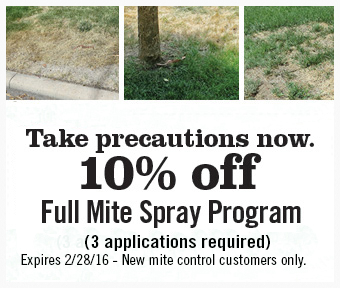


.jpg)
